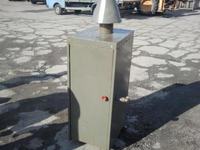koloq wrote: So something is wrong with my connection, I guess you will have to install some valves, but I have to arrange it with the plumber who did it / or for the safety of the new one.
I am also not a professional plumber. And I do not know the practicalities of this type of installations.
However, theoretical knowledge tells me that combining 2 sources into one system should not be done directly.
Assuming parallel operation of 2 heat sources supplied in different ways, even with forced circulation, one should be plugged in through the exchanger.
Not so long ago, I also discussed this in another forum. The guys proved that they have gas boilers connected to the CO system without any exchangers and it is ok. But when one of them wrote that he had a gas boiler installed in the boiler room with a coal boiler, even plugged into the same chimney shaft, I understood that I talk to boiler makers with a high level of amateurism. You just don't do it, because no security regulation allows it.
Back to the topic.
If in the garbage, the installation was correct and you had no problem with heating the rooms, in my opinion the problem lies in the controllability of the boiler.
The inertia of this system is large.
In my opinion, you should lead to the same situation as I have with oats right now.
In short, in full machine it won't go. Or you have to look for an advanced method.
I have practically continuous heating of oats. I only control the water temperature on the system. It is enough and it is OK.
The primitiveness of my controller does not allow to change the temperature of the boiler water depending on the time of day. There is only the set temperature and the end. The boiler works, reaches the set value and if it has it, the burner is stopped.
In this way, during the day, at a boiler temperature of 45-50 in winter (!), It has warmth in the house. I do not cool the installation as it is with extinguishing rubbish.
For me, however, it was too warm at night. I have put the burner off temporarily. This has its drawbacks, but the problem of nighttime temperature drop has been resolved.
If the condensate controller allows it, in my opinion you should give up full weather.
You should give up the control of the room for a test and only switch to controlling the water temperature in the system.
And here, if necessary, introduce the task - lowering the temperature at certain times of the day. I do not know what the controller allows, but in your case it should be done in such a way that the boiler water temperature is set depending on the outside temperature. Possible reduction of the system temperature by 10 degrees during the night (on trial). But not lowering the room temperature! Moving the room temperature by 2-3 degrees is a lot, as long as it has been cooled for a long period of time. Heat the room by 2-3 degrees. It is not the same as warming the air in this room by 2-3 degrees.
You should check how the advice of one of your colleagues is working - other heating time frames. Start earlier and end earlier. This hour or one and a half stop with functioning household members should not matter.
But that will only show a practical approach. Not a theory.
I don't know what the layout of the house is. Do you not have, as with me, that the rooms on the first floor (if any) are slightly cooler? For me, it is the fault of insulation and installation on the first floor converted into thinner pipes. I have the ground floor connected with 3/4 "and the floor with 1/2". Here the physics bows and here you have your answer why the stove once acted to you as it did. Water, despite being forced, will always flow where it has less resistance.
Also, if you have a cooler one upstairs, you should cross the ground floor a little. Posing more resistance to the water.
But here also what I did bows down and I will try to get away from it.
I do not know if this is true, however, without an empirical approach it will not be established.
Similarly, thermostatic valves are valves with a reduced flow compared to traditional ones.
Even though they are fully opened, the flow may be throttled.
After changing my valves to such, I get the impression that it is true. The radiators are cooler than when traditional mushroom valves are used. You can also cover them on them by screwing the knob.
Valves with thermostatic heads are good, but the conditions must be correct for their use. Exposed heads, no objects may obstruct the air circulation. Radio heads work quite nicely, where there are only actuators on the radiators and the controller in a representative place. Solutions such as found in Polish homes, where the thermostatic head is covered by a window curtain, or a sofa pillow or a wardrobe, disqualify their proper operation.
Also. I would check how the pump behaves. A gas boiler is a boiler with a relatively low internal flow. Water flows slowly through the boiler to warm it up quickly and strongly.
Is it not so that the water, as you write, heats up quite quickly, but it is the fault that the pump is running slowly. It heats up quickly, but it is apparent heating. Because when the pump chases her away, she's cold again.
I would try to run the pump to the maximum and gradually lower the speed of work. Fast flow through the boiler = slower heating of water and radiators, but more even and stable.




